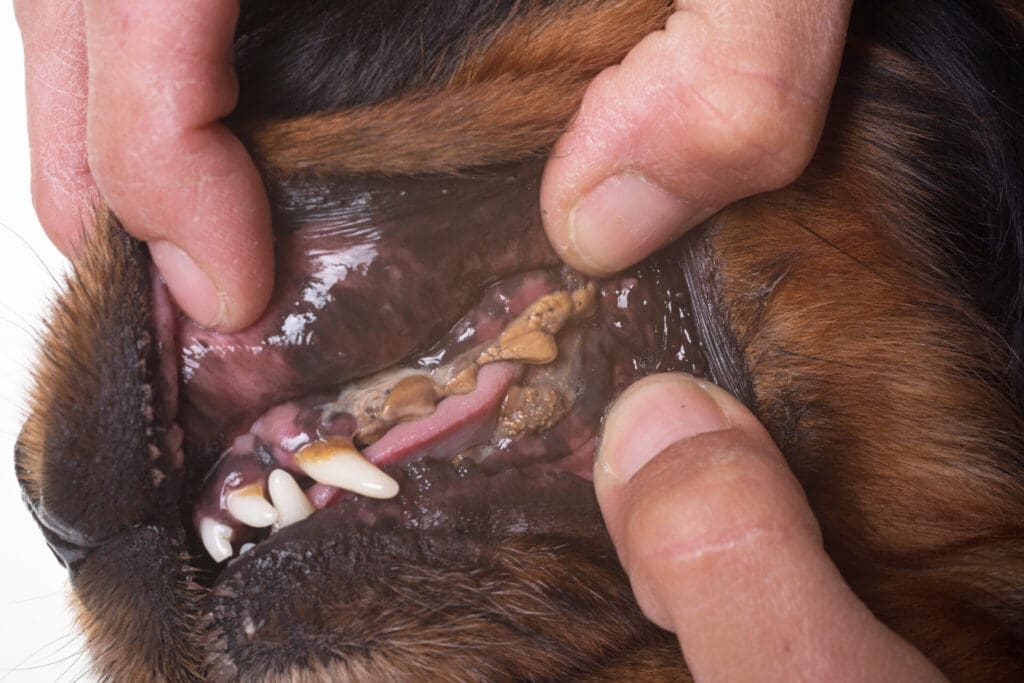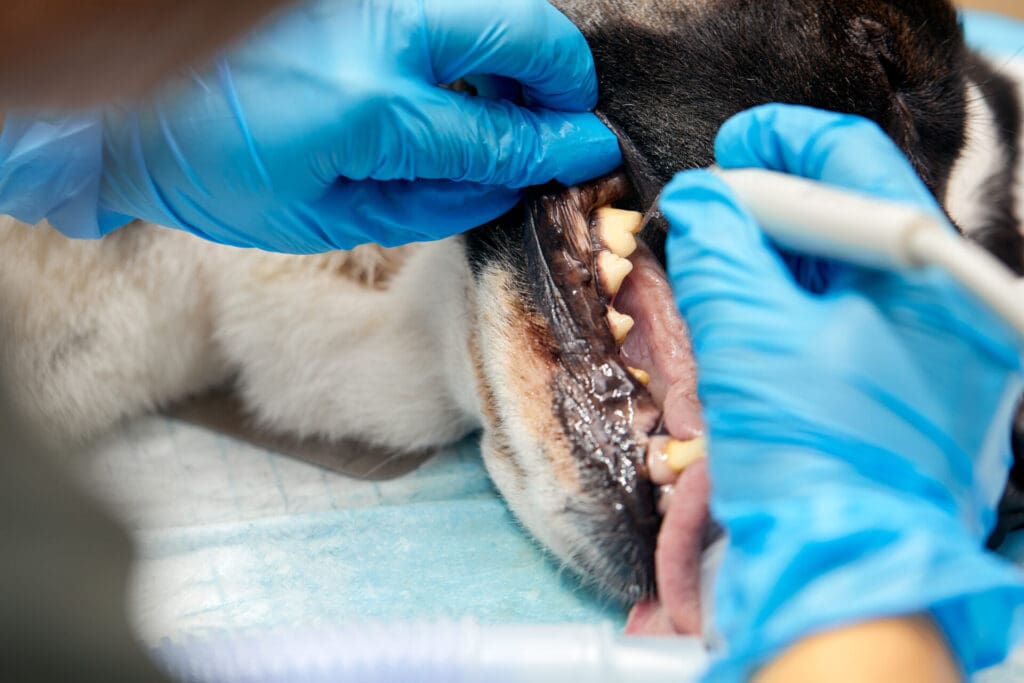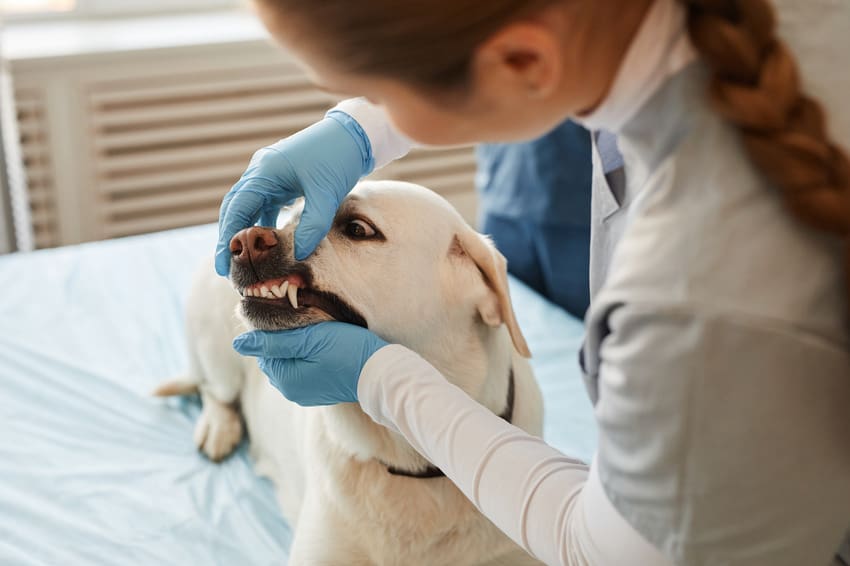Just like humans, pets are vulnerable to dental problems that can lead to serious health issues if left untreated. While dental hygiene may not be the first thing that comes to mind when caring for your furry friend, it plays a major role in their overall well-being. Recognizing signs of dental infection in pets can help prevent pain, tooth loss, and life-threatening conditions.
In this blog, we’ll explore how to identify dental infections, what symptoms to watch out for, and how to respond if you suspect your pet is suffering from one.
Symptoms of Dental Disease in Dogs You Shouldn’t Ignore

Dental disease is incredibly common in dogs, with more than 80% experiencing it by the age of three. Keep a close eye out for these warning signs of dental infection or gum disease in your dog:
- Persistent bad breath (halitosis) that doesn’t improve after brushing or dental chews
- Red, swollen, or bleeding gums (often referred to as dog inflamed gums or dog red gums)
- Yellow or brown tartar buildup on the teeth, especially near the gum line
- Difficulty chewing or dropping food while eating
- Pawing at the mouth or face due to pain or irritation
- Loose or missing teeth
- Reluctance to eat hard food, play with toys, or chew bones
- Excessive drooling or blood in saliva
You may also notice behavioral changes, such as irritability or withdrawal, which can indicate oral pain. Advanced dental disease can allow bacteria to enter the bloodstream, potentially affecting vital organs like the heart, liver, and kidneys. Recognizing these symptoms early and booking a dental exam with your veterinarian is key to preventing serious complications. Professional cleaning and at-home care can help your dog maintain healthy teeth, fresher breath, and overall well-being.
Behavioral Signs of Tooth Abscesses
A tooth abscess occurs when bacteria infect the root of a tooth, leading to inflammation, pus accumulation, and severe pain. According to the AKC Canine Health Foundation, abscesses often form beneath the upper canine or carnassial teeth and can be difficult to spot without veterinary examination.
Dogs with abscesses may:
- Avoid chewing on one side of the mouth or drop food unexpectedly
- Show irritability, withdrawal, or sudden aggression due to chronic pain
- Hide, become less playful, or refuse treats and toys they once enjoyed
- Drool excessively or have saliva tinged with blood
- Rub or paw at their face, sometimes causing swelling beneath the eye or jaw
In severe cases, you might notice a visible bump or swelling under the eye or on the muzzle, which can indicate a ruptured abscess. If you observe any of these symptoms, prompt veterinary care is essential as untreated abscesses can spread infection to the jawbone or bloodstream, leading to more serious health issues.
Can a Dog’s Tooth Infection Go Away on Its Own?
A dental infection in pets, especially in dogs, will not go away without proper treatment. Although some symptoms may temporarily improve, the underlying issue persists and may worsen. Infections can spread to the jawbone or even into the bloodstream, leading to serious systemic illness. If you notice signs of discomfort or swelling in your pet’s mouth, consult your veterinarian immediately.
At-Home Remedies While Waiting for the Vet
While veterinary care is essential, there are a few things you can do at home to support your pet’s oral health:
-
Switch to soft food to ease chewing.
-
Use veterinary-approved dental rinses or water additives.
-
Gently clean around the affected area without applying pressure.
-
Offer dental chews only if your dog is comfortable chewing.
These measures are not cures but may offer temporary relief until your pet can be seen by a professional.
What Happens if a Tooth Abscess is Left Untreated?
Leaving a tooth abscess untreated can lead to:
- Spread of infection to other teeth or bones
- Facial swelling and draining wounds
- Chronic pain and tooth loss
- Kidney, liver, or heart damage from bacteria entering the bloodstream
Prompt treatment is essential to avoid these potentially fatal complications. A tooth abscess in cats or dogs should always be considered an urgent matter.
The Most Common Dental Issues in Dogs
The most widespread dental issue in dogs is periodontal disease, a progressive infection that damages the gums, ligaments, and bone supporting the teeth. Periodontal disease begins with plaque buildup that hardens into tartar if not removed. Over time, this leads to gingivitis (gum inflammation) and eventually tooth decay, bone loss, and tooth loss if untreated.
Other common dental problems include:
- Cavities in dogs (caries): While less common than in humans, cavities can still form, especially in dogs with diets high in carbohydrates or poor oral hygiene.
- Decayed or dead teeth: Chronic infection or trauma can lead to a decayed dog tooth, causing pain and potential abscess formation.
- Fractured or worn-down teeth: Chewing on hard toys, bones, or rocks can fracture teeth, exposing sensitive pulp tissue and leading to infection or discomfort.
- Retained baby teeth: Particularly common in small breeds, these can cause overcrowding and misalignment, trapping food and bacteria that accelerate dental disease.
- Oral tumours or cysts: Though less common, these growths can interfere with chewing, cause bleeding, and require immediate veterinary evaluation.
When left unchecked, these conditions don’t just cause pain or bad breath—they can lead to systemic illness. Bacteria from infected gums can enter the bloodstream, affecting the heart, kidneys, and liver, and shortening a dog’s lifespan. Routine dental care, including professional cleanings and at-home brushing, is vital to preventing these issues and maintaining your pet’s long-term health.
Professional Dental Treatments for Dogs
If your pet is showing signs of a dental infection, the best course of action is professional veterinary care. Dental treatments for dogs and cats may include:
- Scaling and polishing under anesthesia
- Extractions of diseased teeth
- Root canals or crown restorations
- X-rays to detect hidden infections
- Antibiotic therapy to treat bacterial infections
At Spall and Harvey Animal Hospital, we provide complete dental care for pets, whether it’s a routine cleaning or treatment for a decayed dog tooth.
Conclusion: Stay Ahead of Dental Disease
Recognizing signs of dental infection in pets isn’t just about protecting their teeth, it’s about protecting their life. From dogs red gums to tooth abscesses in cats, these problems often start small but can escalate quickly. Regular dental check-ups, proper oral hygiene, and early intervention can save your pet from pain and serious illness.
Don’t wait for symptoms to get worse. Schedule your pet’s dental check-up today at Spall and Harvey Animal Hospital and give them the gift of a happy, healthy smile.


